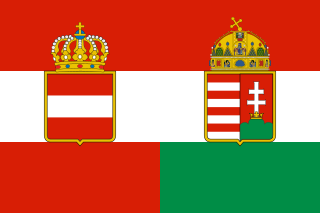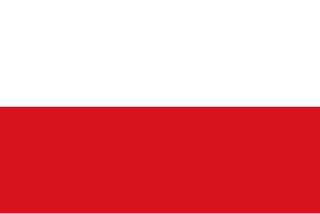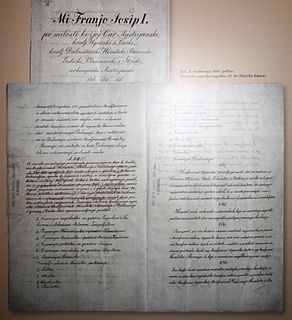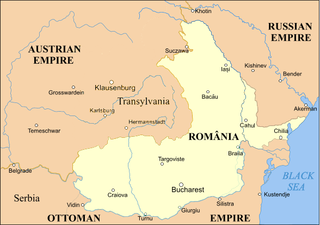
Austria-Hungary, often referred to as the Austro-Hungarian Empire or the Dual Monarchy, was a constitutional monarchy and great power in Central and Eastern Europe between 1867 and 1918. It was formed with the Austro-Hungarian Compromise of 1867, and was dissolved following the First World War.

The Austrian Empire was a Central European multinational great power from 1804 to 1867, created by proclamation out of the realms of the Habsburgs. During its existence, it was the third most populous empire after the Russian Empire and the United Kingdom in Europe. Along with Prussia, it was one of the two major powers of the German Confederation. Geographically, it was the third largest empire in Europe after the Russian Empire and the First French Empire. Proclaimed in response to the First French Empire, it partially overlapped with the Holy Roman Empire until the latter's dissolution in 1806.

The Austro-Hungarian Compromise of 1867 established the dual monarchy of Austria-Hungary. The compromise put an end to the 18 years long military dictatorship and absolutist rule over Hungary, which was introduced by Francis Joseph after the Hungarian Revolution of 1848. The Compromise partially re-established the former sovereignty of the Kingdom of Hungary, however being separate from, but no longer subject to the Austrian Empire. The agreement also restored the old historic constitution of the Kingdom of Hungary.

The Austro-Hungarian Compromise of 1867 established the Dual Monarchy of Austria-Hungary.

The Imperial Council was the legislature of the Austrian Empire from 1861, and from 1867 the legislature of Cisleithania within Austria-Hungary. It was a bicameral body: the upper house was the House of Lords, and the lower house was the House of Deputies. To become law, bills had to be passed by both houses, signed by the government minister responsible, and then granted royal assent by the Emperor. After having been passed, laws were published in the Reichsgesetzblatt. In addition to the Imperial Council, the fifteen individual crown lands of Cisleithania had their own diets.
This article gives an overview of liberalism in Austria. It is limited to liberal parties with substantial support, mainly proved by having had representation in parliament. For inclusion in this scheme it isn't necessary that parties labeled themselves as a liberal party.

Habsburg Monarchy is an umbrella term used by historians for the lands and kingdoms of the House of Habsburg, especially for those of the Austrian line. Although from 1438 until 1806 the head of the House of Habsburg was also Holy Roman Emperor, the Empire itself is not considered a part of the Habsburg Monarchy.

The February Patent was a constitution of the Austrian Empire promulgated in the form of letters patent on 26 February 1861.

The United States of Greater Austria was a proposal, conceived by a group of scholars surrounding Archduke Franz Ferdinand of Austria, that never came to pass. This specific proposal was conceived by the lawyer and politician Aurel Popovici in 1906 and aimed at federalizing Austria-Hungary to help resolve widespread ethnic and nationalist tensions.

Ernest Karl Franz Joseph Thomas Friedrich von Koerber was an Austrian liberal statesman who served as Prime Minister of the Austrian portion of Austro-Hungary in 1900-1904 and 1916.

Adolf Fischhof was a Hungarian-Austrian writer and politician of Jewish descent.
The Resurrection of Hungary: A Parallel for Ireland was a book published by Arthur Griffith in 1904 in which he outlined his ideas for an Anglo-Irish dual monarchy. He proposed that the former kingdoms which had created the United Kingdom of Great Britain and Ireland in 1801, namely, the Kingdom of Great Britain and the Kingdom of Ireland, return to the pre-1801 arrangement whereby they had two governments but a shared king. The policy, which was modelled on Hungary's achievement of equal status with Austria under the Habsburg emperor/king, became the basis for the policy of Griffith's new Sinn Féin party. He proposed a dual monarchy, similar to the equivalent of the Austro-Hungarian Empire, formed under the Compromise of 1867.

Count Karl Sigmund von Hohenwart was an Austrian politician who served as Minister-President of Austria in 1871. Hohenwart’s government attempted to implement a Federalist agreement between Bohemia and the governing Austro-Hungarian Empire. This attempt to conciliate the Bohemian Czechs caused massive criticism, and led to the fall of the Hohenwart government only months after it assumed office.
The Fundamental Articles of 1871 were a set of proposed changes to the Austro-Hungarian constitution regarding the status of the Bohemian Crownlands. Their rejection was largely responsible for the downfall of the Hohenwart cabinet.

The Revolutions of 1848, known in some countries as the Springtime of the Peoples or the Spring of Nations, were a series of political upheavals throughout Europe in 1848. It remains the most widespread revolutionary wave in European history.

Croatian–Hungarian Settlement was a pact signed in 1868, that governed Croatia's political status in the Hungarian-ruled part of Austria-Hungary. It lasted until the end of World War I, when the Croatian Parliament, as the representative of the historical sovereignty of Croatia, decided on October 29, 1918 to end all state and legal ties with the old Austria-Hungary.
"The German Question" was a debate in the 19th century, especially during the Revolutions of 1848, over the best way to achieve the unification of Germany. From 1815 to 1866, about 37 independent German-speaking states existed within the German Confederation. The Großdeutsche Lösung favored unifying all German-speaking peoples under one state, and was promoted by the Austrian Empire and its supporters. The Kleindeutsche Lösung sought only to unify the northern German states and did not include Austria; this proposal was favored by the Kingdom of Prussia.

The Principality of Transylvania, from 1765 the Grand Principality of Transylvania, was a realm of the Hungarian Crown and since 1804 an Austrian crownland ruled by the Habsburg and Habsburg-Lorraine monarchs of the Habsburg Monarchy. During the Hungarian Revolution of 1848, the Hungarian government proclaimed union with Transylvania in the April Laws of 1848 (after the Transylvanian Diet's confirmation on 30 May and the king's approval on 10 June that Transylvania again become an integral part of Hungary. After the failure of the revolution, the March Constitution of Austria decreed that the Principality of Transylvania be a separate crown land entirely independent of Hungary. In 1867, as a result of the Austro-Hungarian Compromise, the principality was reunited with Hungary proper.
The December Constitution is a set of six acts that served as the constitution of the Cisleithanian half of Austria-Hungary. The acts were proclaimed by Emperor Franz Joseph on December 21, 1867 and functioned as the supreme law of the land until the collapse of the empire in 1918. Five of the Constitution's acts were replaced by the Federal Constitutional Law between 1918 and 1920; the sixth law, a bill of rights, is still in force.
The Federalist Party, was less of a party in the traditional sense, than a coalition of various independent politicians, conservatives, and ethnic minority parties, dedicated to the Habsburg monarchy, and the federalization of Cis-Leithanian, i.e. Austrian-dominated, part of the Austrian-Hungarian Dual monarchy.













